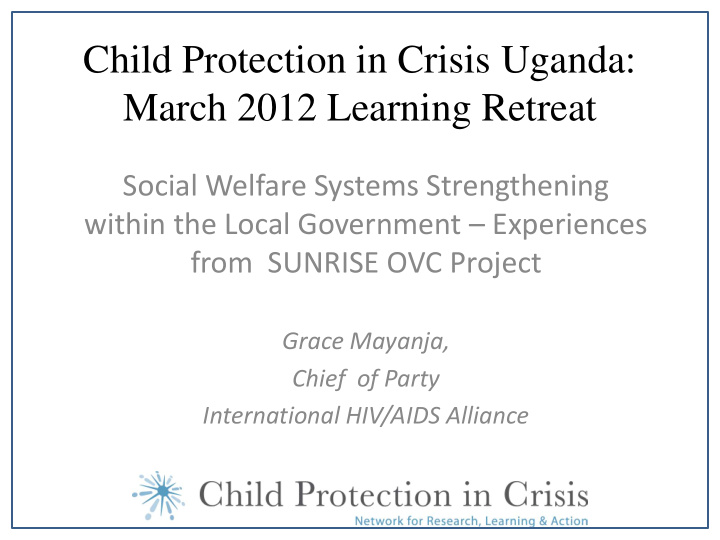



Child Protection in Crisis Uganda: March 2012 Learning Retreat Social Welfare Systems Strengthening within the Local Government – Experiences from SUNRISE OVC Project Grace Mayanja, Chief of Party International HIV/AIDS Alliance
Critical Assumptions • A functioning social welfare system serves as a vital safety net for children and families made vulnerable by HIV/AIDS and other challenging circumstances. • When the system is functioning effectively, families and children have access to an array of quality services that promote wellness and protect them from harm. • Services can include family support and early intervention, child protection to address abuse and neglect and alternative care for children separated from their family of origin.
Strengthening Social Welfare (SW) systems in the local government: Goals • More clearly defined functions and accountabilities • Enhanced management and administration • Adequate, coordinated and well deployed resources • Expanded access to higher quality services • Participation by vulnerable children, families and communities • Alignment of formal and informal systems • Improved data, information and analysis • Consensus building on key priorities • Alignment with global rights regime
Strengthening SW systems in the local government Strengthening Social Welfare systems in the local government: Key Components (LG): Key Components System Key Areas in Local Government Components Institutional • Key Sector Departments; Community Services, Structures Health, Education, Justice, Police, Production etc.. -district, sub • Local Councils county, parish • Multi sectoral and Sector Committees & working and village levels Groups • NGOs/CSOs, FBOs • Communities Critical Functions Policy reforms, governance, planning, budgeting, monitoring and information systems, enforcement of laws, policies, regulations and services provision Institutional • Social Welfare Workforce at all levels, Capacities • Funding for social sector and services, • Infrastructure
Strengthening SW Systems in the LG: Key Strengthening Social Welfare systems in the local government: Key Components Components (Cont.) Key System Key Areas in Local Government Components Continuum of • Prevention and response-to address risks &vulnerability Care • Promotion of visibility of social welfare in development priorities- o Focus on drivers of child vulnerability: Poverty, Armed conflict, high HIV/AIDS prevalence rates, low protective capacity of households, communities and key local government departments Process of • Identification, assessments, investigations, treatment, Care referrals, follow up Accountability • Data collection and information management, standards, research, analysis, advocacy and communication
SSW systems in the LG: Status & Barriers • Mandates and responsibility distributed among/between different ministries - justice, police, education, health etc.. • Unclear or conflicting policy and programmatic mandates • Extremely large numbers of vulnerable children with overwhelming demand for social welfare -51% of children with critical/moderate vulnerability • Little to no resource allocation for social welfare department- 0.5% allocation to Social development sector of the overall GOU annual budget in 2009/2010; 44% district allocations was not released • Marginalized and disempowered social work workforce-59% vacancy rate for Probation, Community Development officers and their assistants responsible for handling social welfare, 72% with no formal training in social work
How SW systems in the LG can be strengthened: SUNRISE Experience • SUNRISE OVC, a 5-year (2010-2015) USAID-PEPFAR funded project • Focuses on strengthening sustainable LG and community systems that have a direct impact on service delivery for children and families made vulnerable by HIV/AIDS and other circumstances. • Works in partnership with Ministry of Gender Labour and Social Development, through the MGLSD’s identified 8 zonal Technical Services Organizations to provide critical technical assistance to 80 districts and Service Providers • Carried out a systems gap assessment in LGs in 2010, and a survey of Human Resource and Funding Status in LGs in 2011
How SW systems in the LG can be strengthened: SUNRISE Activities • District , sub county and community planning & coordination for OVC • Social welfare Workforce planning, skills development & performance improvement • Child protection and Care services provision • Increasing demand & utilization of data and information management on OVC • Monitoring & measuring quality of services to OVC and their households • Improving financing for social services
How SW systems in the LG can be strengthened: SUNRISE Challenges • Overwhelming demand for short term emergency assistance for OVC divert attention from the more longer term and sustainable systems-wide approaches • Limited evidence base on the effective interventions -to respond to large numbers of vulnerable children • Low appreciation of the impact of inaction on OVC on other development goals including MDGs • Protection and care for vulnerable children not among the conditional grants districts
Lessons Learned: The Future Cont. : of Strengthening SW • Maximize local leadership systems in LG requires; • Build on what works • Information, data and analysis • Systems wide approach, not short term projects • Integrate & link social welfare & protection for children in • Service access and quality key national development • Strengthen community systems priorities and initiatives upon which service delivery relies • Effective coordination & • Link the formal and non formal partnerships between CSOs systems and LGs, and between SW sector and other social • Strengthen the protective sectors. capacity of key LG departments • Build key technical and responsible for children leadership skills of LGs, • Build a comprehensive response communities & CSOs
Conclusion • Systemic issues have a direct impact on service delivery for children and families made vulnerable by HIV/AIDS and other circumstances. – Increase focus on systems-wide approaches in LGs • SW and Protection systems development critical for long term effectiveness and sustainability, but adequate time required for building necessary resource base in LGs • Need to strengthen system that reaches down to family/community level • First level of intervention should be at family and community level, before alternative care is arranged
Thank you Discussion
Recommend
More recommend